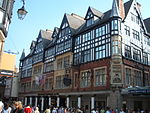Wesley Methodist Church, Chester
1811 establishments in England19th-century Methodist church buildings19th-century churches in the United KingdomChurches in ChesterGrade II listed buildings in Chester ... and 3 more
Grade II listed churches in CheshireMethodist churches in CheshireUse British English from March 2017

The Wesley Methodist Church is in St John Street, Chester, Cheshire, England. It is an active Methodist church in the circuit of Chester. The church is recorded in the National Heritage List for England as a designated Grade II listed building.
Excerpt from the Wikipedia article Wesley Methodist Church, Chester (License: CC BY-SA 3.0, Authors, Images).Wesley Methodist Church, Chester
Saint John Street, Chester Handbridge
Geographical coordinates (GPS) Address Phone number Website External links Nearby Places Show on map
Geographical coordinates (GPS)
| Latitude | Longitude |
|---|---|
| N 53.1898 ° | E -2.888 ° |
Address
Wesley Methodist Church
Saint John Street
CH1 1DA Chester, Handbridge
England, United Kingdom
Open on Google Maps










